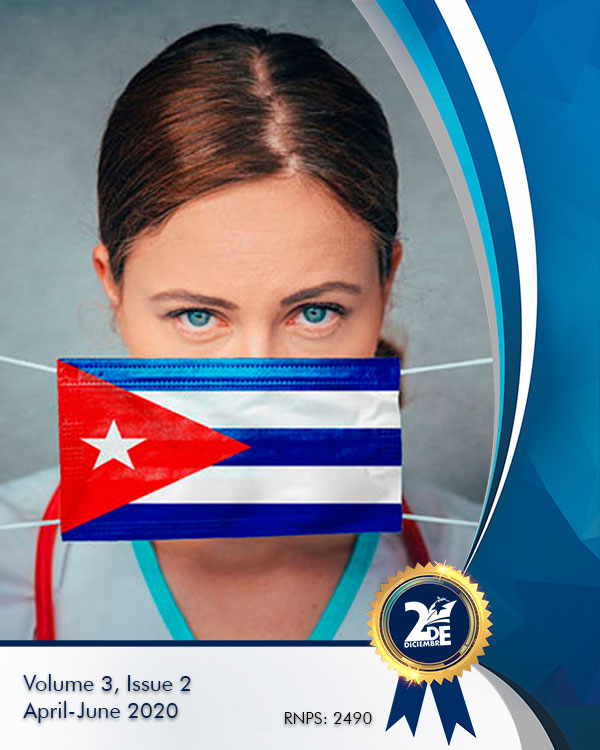Congenital giant melanocytic nevus. A case report
Keywords:
Nevus, Pigmented, Melanoma, DermatologyAbstract
Introduction: Congenital giant melanocytic nevus are infrequent; their incidence is one for every 20 000 to 50 000 live births. They are lesions that tend to change during childhood, associated with complications such as melanoma or neurocutaneous melanosis. They often provoke a significant psychological commitment to parents both for their aesthetics and for their malignancy potential.
Case report: newborn male, white, product of transvaginal delivery, from non-blood parents with no history of birth defects. Physical examination of the skin showed the presence of black pigmented lesions that covered most of the right gluteus, with a potentially heterogeneous and hairy consistency. These lesions were clinically diagnosed as giant congenital melanocytic nevi, without other associated malformations or neurological damage. The patient was discharged with a follow-up by dermatology, genetics and pediatrics.
Conclusions: When dealing with a giant congenital melanocytic nevus, it is necessary to assess the existence of neurocutaneous melanosis or associated malformations. Prenatal diagnosis and genetic counseling, as well as regular check-ups for the risk of malignancy in melanoma, form the basis of treatment.
Downloads
References
1. González-Rubio R, López-Méndez HA, Valencia-Castellanos MA, Aguilar-Rodríguez F, Cristiano-Cristiano F. Recién nacido con Nevo melanocítico congénito gigante en “chaleco”: Reporte de caso. Rev Méd MD [Internet]. 2016 [citado 18 May 2020]; 7(4): 285-288. Disponible en: https://www.medigraphic.com/pdfs/revmed/md-2016/md164o.pdf
2. Díaz Leonard D, Díaz Arjones L, Curbelo Alonso M, Betancourt Trujillo MR, Sánchez Galván LA. Caracterización de pacientes en edad pediátrica con nevos melanocíticos. Medisur [Internet]. 2017 [citado 18 May 2020]; 15(6): 800-806. Disponible en: http://scielo.sld.cu/pdf/ms/v15n6/ms08615.pdf
3. Anco-Gallegos KG, Sánchez-Saldaña L, Sanz-Castro ME. Nevus de Becker segmentario asimétrico unilateral. DERMATOL PERU [Internet]. 2018 [citado 18 May 2020]; 28(1):41-43. Disponible en: http://www.dermatologiaperuana.pe/assets/uploads/revista_TOtP_04_Comunicacion_breve_28-1.pdf
4. Recio A, Sánchez-Moya AI, Félix V, Campos Y. Síndrome del nevus melanocítico congénito. Serie de casos. Actas Dermosifiliogr [Internet]. 2017 [citado 18 May 2020]; 108(9):57-62. Disponible en: https://www.actasdermo.org/es-pdf-S0001731016303714
5. Sarmiento Portal Y, Vara Cuesta OL, Portal Miranda ME, Cabrera Domínguez NB, Pérez Chirino A. Nevus melanocítico gigante congénito. Revista de Ciencias Médicas de Pinar del Río [Internet]. 2014 [citado 18 May 2020]; 18(6): 1110-1117. Disponible en: http://scielo.sld.cu/pdf/rpr/v18n6/rpr17614.pdf
6. Vera-Remartínez EJ, García-Guerrero J. Nevus congénito pigmentado piloso gigante. Rev Esp Sanid Penit [Internet]. 2011 [citado 18 May 2020]; 13(3):112-113. Disponible en: http://scielo.isciii.es/pdf/sanipe/v13n3/06_imagenes.pdf
7. Yori F, Sanjinés L, Badano L, Dufrechou L, Nicoletti S, Larre Borges A. Nevo de Spitz en la infancia: el gran simulador de melanoma. Arch Pediatr Urug [Internet]. 2017 [citado 18 May 2020]; 88(2):101-107. Disponible en: http://www.scielo.edu.uy/pdf/adp/v88n2/v88n2a07.pdf
8. Serra-Guillén C, Traves V, Echeverria B, Martorell A. Nevus del folículo piloso: aportación de un caso y revisión de la literatura. Actas Dermosifiliogr [Internet]. 2009 [citado 18 May 2020]; 100: 822-824. Disponible en: https://www.actasdermo.org/es-pdf-S0001731009725608
9. Alcalá Pérez D, Valente Duarte de Sousa IC. Nevos melanocíticos y no melanocíticos. Revisión de la literatura. Rev Cent Dermatol [Internet]. 2010 [citado 18 May 2020]; 19(2): 49-58. Disponible en: https://www.medigraphic.com/pdfs/derma/cd-2010/cd102a.pdf
10. Pastor M, Dufrechou L, Nicoletti S, Larre Borges A.Nevos melanocíticos congénitos. Arch Pediatr Urug [Internet]. 2019 [citado 18 May 2020]; 90(6): 321-327.Disponible en: http://www.scielo.edu.uy/pdf/adp/v90n6/1688-1249-adp-90-06-321.pdf
Downloads
Published
How to Cite
Issue
Section
License
Authors who have publications with this journal agree to the following terms: authors retain their copyright and grant the journal the right of first publication of their work, which is simultaneously subject to the Creative Commons Attribution-NonCommercial 4.0 International License that allows third parties to share the work as long as the author and first publication in this journal are indicated, for non-commercial use. Authors may adopt other non-exclusive license agreements for distribution of the published version of the work (e.g., depositing it in an institutional telematic archive or publishing it in a monographic volume) as long as the initial publication in this journal is indicated. Authors are allowed and encouraged to disseminate their work via the Internet (e.g., in institutional telematic archives, in their web page or in Pre-print servers) before and during the submission process, which can lead to interesting exchanges and increase citations of the published work. (See The Open Access Effect).







